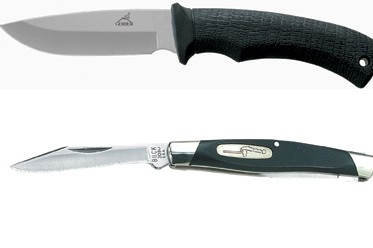How to Choose Just the Right Knife for Your Hunting Needs
Advertisement
The very first hunting knife I ever bought was a beauty. It was 10 1/2 inches long, complete with a six-inch blade, an ebony-coloured phenolic handle and a black leather sheath. All in all, it was a very rugged, imposing knife. As it turned out, though, it was virtually useless for the tasks I expected it to perform. As an impressionable youngster, I had been caught up in the allure of knives.
But with experience comes wisdom, and I’ve since learned that not all knives are created equal. The right knife for the job is a pleasure to use; the wrong one just leaves you frustrated.
Advertisement
When it comes to an all-around, big-game hunting knife, I prefer a blade in the four-inch range. At this length it’s easy to control—ensuring a better, safer job-while still providing the strength required for tackling larger game. I also prefer a knife with a sharp point that’s slightly dropped. The sharp point makes it easy to pierce an animal’s hide or abdominal cavity, while the drop point allows you to control the tip with your finger, resulting in fewer unwanted cuts to the animal. The drop point is also much safer to use, especially when you can’t see your hands, such as when you’re cutting deep in the chest cavity of a moose.
Knives with a raised tip (called a trailing point) do have their place. In particular, they’re well suited to the task of caping. The sharp, extended point allows you to effectively manoeuvre within the tight tolerances required for a quality caping job.
For the task of skinning, there’s one primary characteristic I look for in a knife: a blade that has a rounded or deeply curved cutting edge. This makes the job considerably more efficient while reducing the likelihood of unwanted cuts into the hide or meat.
Advertisement
Speaking of unwanted cuts, if you select a folding-blade model for big game, make sure it locks in the open position. Non-locking folders tend to close unexpectedly, and that can cause serious injury. While I’ve occasionally carried a Buck Model 110 folder, over time I’ve come to prefer the solid feel and strength of a fixed-blade knife when dealing with animals larger than deer.
As for handles on big-game knives, they come in a variety of materials, and each one has its own function and appeal. Generally speaking, look for a handle that fits your hand and feels comfortable. I prefer softer handles made of rubber-based materials that provide a much surer grip, even when wet.
For bird and small-game hunting, meanwhile, I use a narrow, three-inch-long blade that’s relatively flexible. I have a couple of fixed-blade models, but I often use folders that might best be categorized as pocket knives. I keep them very sharp and appreciate their versatility for boning grouse, waterfowl or small mammals, as well as handling a number of routine camp chores.
One last thing to decide is whether you want a blade made of carbon steel or stainless steel. Carbon steel is easier to sharpen-a benefit to sportsmen who have difficulty getting and keeping a good edge on their knives-but it requires more care, as it’s susceptible to stains and rust. Stainless steel, on the other hand, is much more difficult to hone, though once sharp, it retains its edge longer. Stainless steel is easy to care for, and I advise those prone to abusing their field equipment to consider this option instead.
Regardless of which blade material you choose, a sharp blade is much safer and more effective than a dull one. If you must, get a professional to establish a keen edge on your knife. Keeping a knife sharp is far easier than trying to bring a dull blade back to life. A properly maintained knife can last a lifetime-and judging by the number of knives I own, I must be preparing to live forever.
Tips
When shopping for your next new hunting knife, be sure to keep the following points in mind:
- Select a blade shape and style that suits its intended purpose
- Ensure the knife is comfortable and balanced in your hand
- Buy quality, brand-name knives (which often come with guarantees) and you can be reasonably assured they’ll hold an edge and, if maintained, function for years to come

